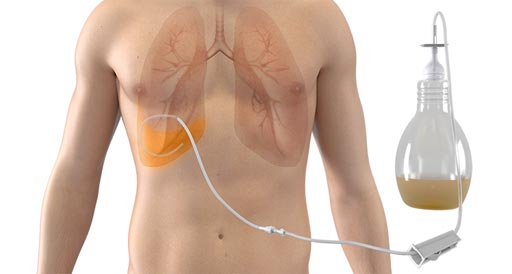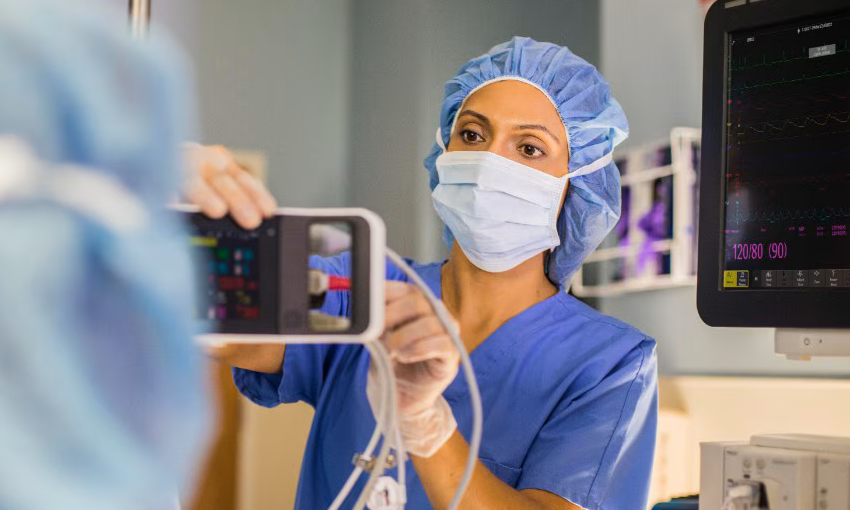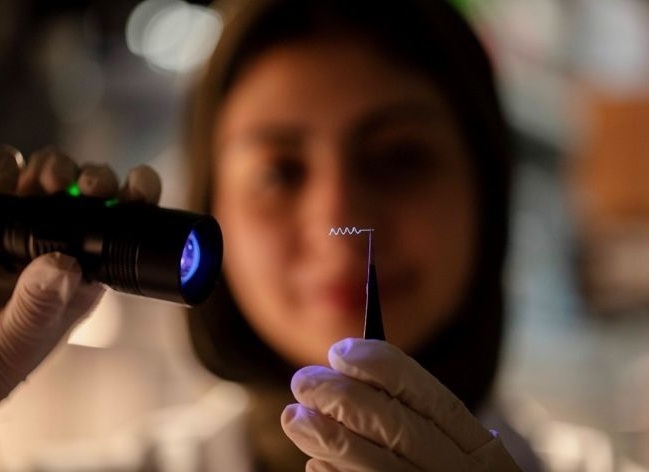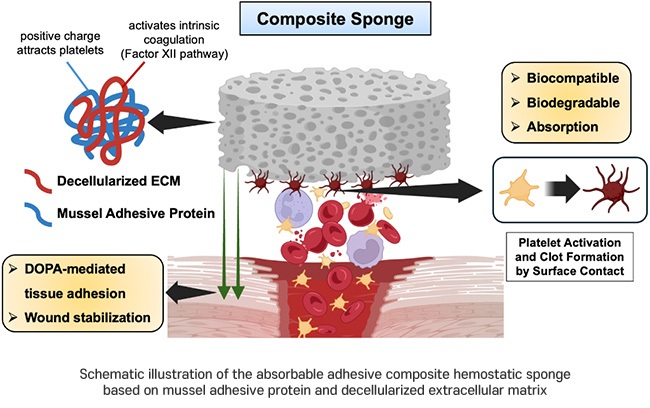Catheter System Drains Recurrent Pleural Effusions
|
By HospiMedica International staff writers Posted on 08 Feb 2017 |

Image: The PleurX catheter system for draining pleural effusions (Photo courtesy of BD).
A novel catheter system enables patients to drain pleural fluid at home, instead of requiring them to return to the hospital for thoracentesis.
The PleurX catheter system consists of a catheter that is inserted in the chest wall for draining pleural effusions, or into the abdomen for malignant ascites, and proprietary drainage bottles. To drain pleural fluids, the free end of the catheter is connected to the drainage line on the external vacuum bottle, which then automatically draws out the fluid by pressure differential; a roller clamp controls flow on the drainage line. The kit also features a self-adhesive dressing used to maintain the catheter discrete and clean.
The PleurX catheter can also be used in place of a chest tube for the delivery of talc or bleomycin for chemical pleurodesis, offering an additional treatment option. Potential complications can include pneumothorax, re-expansion pulmonary edema, hypotension, circulatory collapse, and infection of the pleural space. It is also not recommended to drain more than 1,000 mL of fluid at any one time. The PleurX catheter system is a product of BD, formerly known as Becton Dickinson, and has been approved by the U.S. Food and Drug Administration (FDA).
“BD can provide patients who suffer from recurrent pleural effusions due to congestive heart failure and other non-malignant recurrent pleural effusion etiologies with an option to manage their symptoms from the comfort of their home,” said Jim Leitl, worldwide vice president and general manager for interventional specialties at BD. “The system helps patients take control of their therapy by enabling them to manage fluid from pleural effusions outside of the hospital. Patients now have the option to potentially avoid the mental and physical toll of undergoing an additional hospital procedure.”
“Our research found that the PleurX catheter provided palliation of congestive heart failure patients' pleural effusions and freedom from re-intervention equal to that of talc pleurodesis using thoracoscopy, while resulting in a shorter mean length of hospital stay,” said Richard Freeman, MD, regional chief medical officer of St. Vincent Indianapolis. “Lower rates of operative morbidity and readmission related to the pleural effusion were also seen in the PleurX catheter treatment group.”
Pleural effusion results in an excessive amount of fluid buildup in the space between the layers of pleura that surround the lung. The fluid may be categorized as either transudate, which is usually composed of ultrafiltrates of plasma resulting from an imbalance in vascular hydrostatic and oncotic forces in the chest (such as in heart failure or cirrhosis); or as exudate, which is typically produced by inflammatory conditions (such as lung infection or a malignancy). Exudative pleural effusions are usually more serious and difficult to treat.
The PleurX catheter system consists of a catheter that is inserted in the chest wall for draining pleural effusions, or into the abdomen for malignant ascites, and proprietary drainage bottles. To drain pleural fluids, the free end of the catheter is connected to the drainage line on the external vacuum bottle, which then automatically draws out the fluid by pressure differential; a roller clamp controls flow on the drainage line. The kit also features a self-adhesive dressing used to maintain the catheter discrete and clean.
The PleurX catheter can also be used in place of a chest tube for the delivery of talc or bleomycin for chemical pleurodesis, offering an additional treatment option. Potential complications can include pneumothorax, re-expansion pulmonary edema, hypotension, circulatory collapse, and infection of the pleural space. It is also not recommended to drain more than 1,000 mL of fluid at any one time. The PleurX catheter system is a product of BD, formerly known as Becton Dickinson, and has been approved by the U.S. Food and Drug Administration (FDA).
“BD can provide patients who suffer from recurrent pleural effusions due to congestive heart failure and other non-malignant recurrent pleural effusion etiologies with an option to manage their symptoms from the comfort of their home,” said Jim Leitl, worldwide vice president and general manager for interventional specialties at BD. “The system helps patients take control of their therapy by enabling them to manage fluid from pleural effusions outside of the hospital. Patients now have the option to potentially avoid the mental and physical toll of undergoing an additional hospital procedure.”
“Our research found that the PleurX catheter provided palliation of congestive heart failure patients' pleural effusions and freedom from re-intervention equal to that of talc pleurodesis using thoracoscopy, while resulting in a shorter mean length of hospital stay,” said Richard Freeman, MD, regional chief medical officer of St. Vincent Indianapolis. “Lower rates of operative morbidity and readmission related to the pleural effusion were also seen in the PleurX catheter treatment group.”
Pleural effusion results in an excessive amount of fluid buildup in the space between the layers of pleura that surround the lung. The fluid may be categorized as either transudate, which is usually composed of ultrafiltrates of plasma resulting from an imbalance in vascular hydrostatic and oncotic forces in the chest (such as in heart failure or cirrhosis); or as exudate, which is typically produced by inflammatory conditions (such as lung infection or a malignancy). Exudative pleural effusions are usually more serious and difficult to treat.
Latest Critical Care News
- 'Universal' Kidney to Match Any Blood Type
- AI Heart Attack Risk Assessment Tool Outperforms Existing Methods
- Smartphone Imaging System Enables Early Oral Cancer Detection
- Swallowable Pill-Sized Bioprinter Treats GI Tract Injuries

- Personalized Brain “Pacemakers” Could Help Patients with Hard-To-Treat Epilepsy
- Microscopic DNA Flower Robots to Enable Precision Medicine Delivery
- Origami Robots to Deliver Medicine Less Invasively and More Effectively
- Improved Cough-Detection Technology Aids Health Monitoring
- AI Identifies Children in ER Likely to Develop Sepsis Within 48 Hours
- New Radiofrequency Therapy Slows Glioblastoma Growth
- Battery-Free Wireless Multi-Sensing Platform Revolutionizes Pressure Injury Detection
- Multimodal AI to Revolutionize Cardiovascular Disease Diagnosis and Treatment
- AI System Reveals Hidden Diagnostic Patterns in Electronic Health Records
- Highly Sensitive On-Skin Sensing Monitor Detects Vitamin B6 and Glucose in Sweat
- Artificial Intelligence Revolutionizing Pediatric Anesthesia Management
- New Device Detects Tuberculosis DNA Directly in Exhaled Air
Channels
Surgical Techniques
view channel
Minimally Invasive Endoscopic Surgery Improves Severe Stroke Outcomes
Intracerebral hemorrhage, a type of stroke caused by bleeding deep within the brain, remains one of the most challenging neurological emergencies to treat. Accounting for about 15% of all strokes, it carries... Read more
Novel Glue Prevents Complications After Breast Cancer Surgery
Seroma and prolonged lymphorrhea are among the most common complications following axillary lymphadenectomy in breast cancer patients. These postoperative issues can delay recovery and postpone the start... Read morePatient Care
view channel
Revolutionary Automatic IV-Line Flushing Device to Enhance Infusion Care
More than 80% of in-hospital patients receive intravenous (IV) therapy. Every dose of IV medicine delivered in a small volume (<250 mL) infusion bag should be followed by subsequent flushing to ensure... Read more
VR Training Tool Combats Contamination of Portable Medical Equipment
Healthcare-associated infections (HAIs) impact one in every 31 patients, cause nearly 100,000 deaths each year, and cost USD 28.4 billion in direct medical expenses. Notably, up to 75% of these infections... Read more
Portable Biosensor Platform to Reduce Hospital-Acquired Infections
Approximately 4 million patients in the European Union acquire healthcare-associated infections (HAIs) or nosocomial infections each year, with around 37,000 deaths directly resulting from these infections,... Read moreFirst-Of-Its-Kind Portable Germicidal Light Technology Disinfects High-Touch Clinical Surfaces in Seconds
Reducing healthcare-acquired infections (HAIs) remains a pressing issue within global healthcare systems. In the United States alone, 1.7 million patients contract HAIs annually, leading to approximately... Read moreHealth IT
view channel
Printable Molecule-Selective Nanoparticles Enable Mass Production of Wearable Biosensors
The future of medicine is likely to focus on the personalization of healthcare—understanding exactly what an individual requires and delivering the appropriate combination of nutrients, metabolites, and... Read moreBusiness
view channel
Philips and Masimo Partner to Advance Patient Monitoring Measurement Technologies
Royal Philips (Amsterdam, Netherlands) and Masimo (Irvine, California, USA) have renewed their multi-year strategic collaboration, combining Philips’ expertise in patient monitoring with Masimo’s noninvasive... Read more
B. Braun Acquires Digital Microsurgery Company True Digital Surgery
The high-end microsurgery market in neurosurgery, spine, and ENT is undergoing a significant transformation. Traditional analog microscopes are giving way to digital exoscopes, which provide improved visualization,... Read more
CMEF 2025 to Promote Holistic and High-Quality Development of Medical and Health Industry
The 92nd China International Medical Equipment Fair (CMEF 2025) Autumn Exhibition is scheduled to be held from September 26 to 29 at the China Import and Export Fair Complex (Canton Fair Complex) in Guangzhou.... Read more














